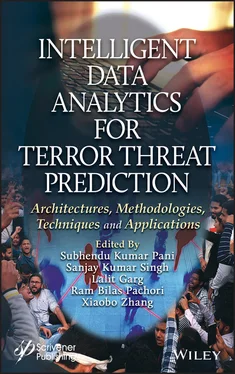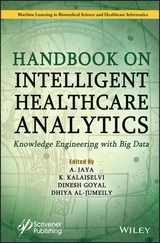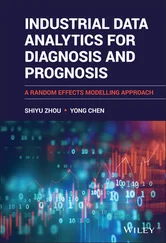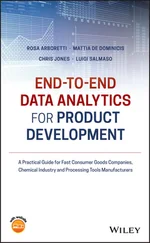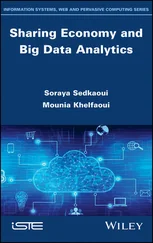Library of Congress Cataloging-in-Publication Data
ISBN 978-1-119-71109-4
Cover image: www.Pixabay.Com
Cover design by Russell Richardson
Set in size of 11pt and Minion Pro by Manila Typesetting Company, Makati, Philippines
Printed in the USA
10 9 8 7 6 5 4 3 2 1
Intelligent data analytics for terror threat prediction is an emerging field of research at the intersection of information science and computer science. Intelligent data analytics for terror threat prediction is a new era that brings tremendous opportunities and challenges due to easily available criminal data for further analysis. The aim of this data analytics is to prevent threats before they happen using classical statistical issues, machine learning and artificial intelligence, rule induction methods, neural networks, fuzzy logic, and stochastic search methods on various data sources including social media, GPS devices, video feeds from street cameras and license-plate readers, travel and credit-card records and the news media, as well as government and propriety systems. Intelligent data analytics is to ensure the efficient data mining techniques to get solutions for crime investigation. Prediction of future terrorist attacks according to city, attack type, target type, claim mode, weapon type and motive of attack through classification techniques, facilitates the decision making process by security organizations, as well as to learn from the previous stored attack information and then rate the targeted sectors/areas accordingly for security measures. Intelligent data analytics models with multiple level of representation in which at each level the system learns raw to higher abstract level representation. Intelligent data analytics-based algorithms have demonstrated great performance to a variety of areas including data visualization, data pre-processing (fusion, editing, transformation, filtering, and sampling), data engineering, database mining techniques, tools and applications, etc.
This edited book, titled “Intelligent Data Analytics for Terror Threat Prediction” emerges as a consequence of the vital need for public safety in various domains and parts of the world. It is particularly targeted at resource constrained environments such as in developing nations, where crime is growing at a frightening rate across various domains of life and impeding economic growth. By source constrained situation, we mean environments where crime intelligence skilled personnel are limited and inadequate technological solutions are in place to gather operational safety information for citizens’ security. In particular, of interest is the quest to realize the nature, scope and level of impact of present crime mining solutions across various domains and to develop novel paradigms for a more comprehensive solution. This will present innovative insights that will help to obtain interventions to undertake emerging dynamic scenarios of criminal activities. Further, this book presents emerging issues, challenges and management strategies in public safety and crime control development across various domains. The book will play a vital role in improving human life to a great extent. All researchers and practitioners will highly benefit from reading this book, especially those who are working in the fields of data mining, machine learning, and artificial intelligence. This book is a good collection on the state-of-the-art approaches for intelligent data analytics. It will be very beneficial for the new researchers and practitioners working in the field to quickly know the best performing methods.
Organization of the Book
This book consists of 14 chapters. It includes quality chapters that present scientific concepts, framework and ideas on intelligent data analytics for terror threat prediction across different crime domains. The editors and expert reviewers have confirmed the high caliber of chapters through careful refereeing of the papers. For the purpose of coherence, we have organized the chapters with respect to similarity of topic addressed. The topics addressed range from crime mining issues pertaining to cyber-crime, cyber-crimes on social media, intrusion detection system, cryptography Internet of Things (IoT) and machine to machine comm. and analysis of crime scenarios.
Chapter 1, “Rumor Detection and Tracing its Source to Prevent Cyber-Crimes on Social Media” by Ravi Kishore Devarapalli, Anupam Biswas, presents the different automated rumor detection systems in social net-works and techniques to trace the source of rumor.
Chapter 2, “Internet of Things (IoT) and Machine to Machine (M2M) Communication Techniques for Cyber Crime Prediction” by Jaiprakash Narain Dwivedi presents a response to crime issues by offering a novel security structure that is based on the examination of the “limits and capacities” of M2M devices and improves the structures headway life cycle for the general IoT natural framework.
In Chapter 3, “Crime Predictive Model Using Big Data Analytics” by Hemanta Kumar Bhuyan and Subhendu Kumar Pani presents detailed information on the methods of machine learning to develop different techniques to catch criminals based on their track of activities.
Sushobhan Majumdar presents an important discussion and analysis in Chapter 4on “The Role of Remote Sensing and GIS in Military Strategy to Prevent Terror Attacks”. He focuses on the role of RS and GIS in constructing defense strategies to prevent terror attacks.
In Chapter 5, Supriya Raheja and Geetika Munjal present “Text Mining for Secure Cyber Space”. The chapter presents an expert system for extracting similarity score of cyber-attack related keywords among various resources. The proposed work uses text mining approach for making a secure cyber space.
R. Arshath Raja, N. Yuvaraj, and N.V. Kousik provide an insightful discussion and analysis in Chapter 6on “Analyses on Artificial Intelligence Framework to Detect the Crime Pattern”. The chapter describes the performance of the proposed clustering model for crime pattern investigation and is compared with time series analysis, support vector machine, artificial neural network. The analysis is carried out against various performance metrics that includes: accuracy, specificity, sensitivity and f-measure.
In Chapter 7, Ebrahim A.M. Alrahawe, Vikas T. Humbe, and G.N. Shinde present the issue of “Biometric Technology-Based Framework for Tackling and Preventing Crimes”. The chapter provides an insight into the possibility of integrating surveillance systems with biometric systems at a single system in order to predict crime by identifying criminals and crime tools.
In Chapter 8, Supriya Raheja, Geetika Munjal, Jyoti Jangra, and Rakesh Garg provide a useful discussion “Rule-Based Approach for Botnet Behavior Analysis”. The chapter also proposes that botnet traffic in any network is a matter of serious concern. They are used for many activities of malicious type like distributed denial of service (DDOS) attacks, mass spam, phishing attacks, click frauds, stealing the user’s confidential infor-mation like passwords and other types of cyber-crimes.
Abhishek Goel, Siddharth Gautam, Nitin Tyagi, Nikhil Sharma, and Martin Sagayam present an important discussion and analysis in Chapter 9on the role of “Securing Biometric Framework with Cryptanalysis”. The chapter investigates the different contentions for and against biometrics and argues that while biometrics may present real protection concerns, these issues can be satisfactorily ameliorated.
In Chapter 10, Galal A. Al-Rummana, Abdulrazzaq H.A. Al-Ahdal and G. N. Shinde present “The Role of Big Data Analysis in Increasing the Crime Prediction and Prevention Rates”. The chapter discusses different big data analysis techniques.
Читать дальше
